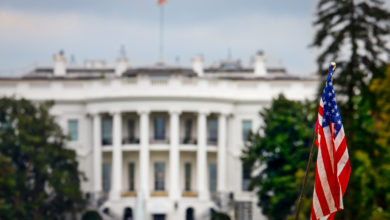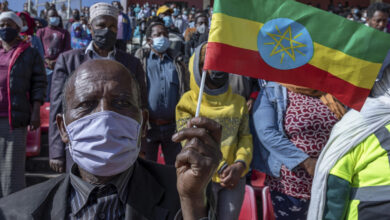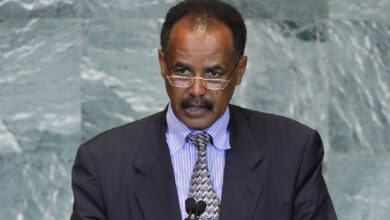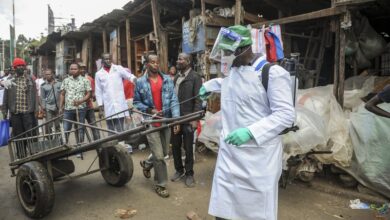Eritrea
Eritrea, in long form the state of Eritrea is a country in the Horn of Africa, independent from Ethiopia since 1993. Following the purchase by the Italians of the bay of Assab, to the local sultan in 1869, then of their occupation of Massaoua in 1885, Eritrea is constituted in 1890 in particular territory. After the Italian defeat during the Second World War, the UN decided in 1952 to federate Eritrea with Ethiopia, which annexed it in 1962. It was the start of the war of independence which ended in May 1991 by the victory of the independence movement, the Popular Front for the Liberation of Eritrea (FPLE) led by Isaias Afwerki, and therefore by the defeat of the Ethiopian government. Eritrea thus gained independence in 1993. The two countries remained in a state of war until the signing of a peace treaty in 2018. Since the beginning of the 2000s, Eritrea, still led by Isaias Afwerki, has adopted a repressive and authoritarian attitude, in particular via indefinite military service (6.5 years on average), which has led to a significant emigration movement and leads to several descriptions of the country as an “open-air prison”. Many media describe the country as a state ruled by a totalitarian regime. There is no real institution in the country and most of the power is concentrated in the hands of its president, Isaias Afwerki. Eritrea suffered from the draconian sanctions imposed by the UN in December 2009 and reinforced in December 2011. Eritrea is one of the countries with the lowest Human Development Index (HDI) in the world with 0.35 for a population of around six million.
Eritrea’s history
The oldest known reference to the Eritrean Sea is attributed to Eschyle (Fragment 67), who designates it as the jewel of Ethiopia . Around the eighth century BC. AD, a kingdom known as D’mt is established in the north of Eritrea and Ethiopia, with Yeha as its capital. It was followed by the kingdom of Aksum, in the 1st century BC. J.-C . The Eritrean Sea Journey, a third-century document, points out that there was a trade route in East Africa that linked the Roman world to China. The peoples of central Eritrea and the north of what is now Ethiopia share a common historical and cultural heritage, stemming from the kingdom of Aksum and the dynasties that followed throughout the first millennium BC. AD and the Guèze language. The kingdom of Aksum, from the fourth century BC. Preceded by the kingdom of D’mt, it covered a large part of present-day Eritrea and northern Ethiopia. It reached its peak in the first century BC. AD and later adopted Christianity.
Prehistory
Eritrea is considered, with Ethiopia, Punt in Somalia and the coast of Sudan, as one of the possible localizations of the country called Pays de Punt or Ta Netjeru (~ 2500 BC) by the Egyptians, whose first mention dates back to the fifteenth century BC. Its location is however uncertain. The majority of authors today locate the site on the African Red Sea coast.
Antiquity
Around 1000 BC until about 400 AD. AD, the kingdom of Sheba was a state located between present-day Yemen, Eritrea or northern Ethiopia depending on the period. Subsequently, D’mt (800 BC to 600 BC) was a state that spanned the present region of Eritrea and northern Ethiopia. The kingdom of Aksum (100 BC to 990 AD) was an important trading state. He would have collected the Ark of the Covenant, brought back by Menelik I, the son of King Solomon and the Queen of Sheba. Aksum was also the first great empire to convert to Christianity. Eritrea is considered, with Ethiopia, Punt in Somalia and the coast of Sudan, as one of the possible localizations of the country called Pays de Punt or Ta Netjeru (~ 2500 BC) by the Egyptians, whose first mention dates back to the fifteenth century BC. Its location is however uncertain. The majority of authors today locate the site on the African Red Sea coast. antiquity Around 1000 BC. Until about 400 AD. AD, the kingdom of Sheba was a state located between present-day Yemen, Eritrea or northern Ethiopia depending on the period. Subsequently, D’mt (800 BC to 600 BC) was a state that spanned the present region of Eritrea and northern Ethiopia. The kingdom of Aksum (100 BC to 990 AD) was an important trading state. He would have collected the Ark of the Covenant, brought back by Menelik I, the son of King Solomon and the Queen of Sheba. Aksum was also the first great empire to convert to Christianity.
Middle Ages
From 990 to 1270, the Zagwé dynasty took power. The Zagwé are an Orthodox Christian family from the Lasta who reigned in Ethiopia. It succeeds the kingdom of Aksum. From 1270 to 1755, it was the Solomonid dynasty who ruled, claiming the descendants of King Solomon and the Queen of Sheba, who is said to have given birth to the first King Menelik I (circa -950) after his visit to Solomon, recounted in the Bible, in the city of Jerusalem. It is also one of the two oldest royal houses in the world along with the imperial house of Japan. Zemene Mesafent (1755 to 1855) is then a period during which the emperors “reigned but did not govern”.
Italian colonization
The administrative divisions of Italian East Africa from 1936 to 1940. Eritrea, one lira coin, front and back, dating from 1891, bearing the effigy of Humbert I, King of Italy. Italy began to engage on the shores of the Red Sea on November 17, 1869, when the Società di Navigazione Rubattino bought the bay of Assab from the local sultan9,10. On July 5, 1882, the Italian government took control of the port of Assab by decree11. Three years later, in 1885, Italy replaced the Anglo-Egyptians in the port of Massaoua and then began to conquer the interior9. The colony of Eritrea which brings together the two territories was created on January 1, 1890. The Italian advance in Ethiopia was stopped at the battle of Adoua in 1896. In 1935, the Italians attacked Ethiopia again from their colonies in Eritrea and Somalia. Following this new war, they created the Italian Empire of Ethiopia. From 1936, Eritrean territory was integrated into Italian East Africa.
British offensive (Alliance) and Italian defeat (Axis)
The British invaded Eritrea on January 18, 1941, the day of the capture of Kassala on the border with Sudan. Operations are led by Lieutenant-General William Platt, commander of the British forces in Sudan14. The 4th and 5th Indian infantry divisions, commanded respectively by the major-generals Noel Beresford-Peirse and Lewis Heath, progress during the following two weeks in direction of the fortified city of Agordat. The 4th Indian division takes the northern route through Sabderat, Keru and Agordat and the 5th Indian division takes the southern route through Tessenei and Barentu. They cover 160 km in 9 days and successively remove several cities from the Italians. They pierce the Italian positions in the hills and take Agordat on February 1, after two days of combat (4th division), and Barentu the next day (5th division). The decisive campaign battle took place in Keren, a town 100 kilometers east of Agordat. The Battle of Keren marks a turning point in the British conquest of Eritrea and Ethiopia. After this confrontation, the resistance of the Italian troops is much weaker. According to Pierre Messmer, the Italians believe that they are no longer able to achieve victory in this theater of operations and the capitulation of their units is generally rapid. The 5th Indian division then heads to the capital Asmara, 80 kilometers east of Keren, while the 4th Indian division stays in Keren for a few days and returns to Egypt in early April. Asmara is declared open city and the British troops seize it on April 1. Three days later, the 10th Indian brigade headed for Massaoua, located a hundred kilometers from Asmara, on the coast. The Italians have 10,000 men, tanks and armored vehicles to defend Massaoua, a strategic port objective. After some initial confrontations, the resistance collapsed and the Indian units and the French brigade of the Orient took Massaoua on April 8, 20.
From annexation by Ethiopia to independence
Following Allied victories in the spring of 1941, the British then administered Eritrea. From 1942, various projects were developed for the future of the territory. The armistice, signed by Italy on September 3, 1943, contains no provision concerning the former Italian colonies. As early as 1944, the United Nations and the United States proposed to link Eritrea to Ethiopia, which claimed a port on the Red Sea. At international conferences (Potsdam, London, Paris), several solutions were discussed (partition, independence, attachment to Ethiopia, etc.), without a solution being found when the peace was signed on February 10, 1947. In the absence of agreement between the powers, the question was referred to the United Nations in September 1948. The United States wished to keep its bases installed in Massaoua and Asmara, which seemed to them to be guaranteed by a connection with Ethiopia. In May 1949, the Bevin-Sforza agreement provided for the partition of Eritrea between Sudan and Ethiopia, but it was rejected by the UN Assembly. It was ultimately resolution 390 (v) of December 2, 1950 that made Eritrea “an autonomous unit, federated with Ethiopia under the sovereignty of the Ethiopian crown”. This resolution provides that the final federal act must be ratified by the future Eritrean National Assembly, and during the proclamation of the future Eritrean Constitution. These first parliamentary elections took place on March 16, 1952 under the supervision of a United Nations commission [ref. desired]. A representative assembly of 68 members is elected by the Eritreans. The assembly approves the draft constitution proposed by the UN on July 10, 1952. On September 11, 1952, the Emperor of Ethiopia, Haile Selassie, ratifies the constitution. The Representative Assembly then becomes the Eritrean Assembly and the United Nations resolution to federate Eritrea with Ethiopia becomes effective. It is confirmed by a new resolution of September 15, 1952. Eritrea and Ethiopia are then linked by a fairly flexible federal structure under the sovereignty of the emperor. Eritrea has its own administrative and judicial organization, its own flag and autonomy over its internal affairs, including the police, local administration and taxation. The imperial federal government is responsible for foreign affairs (including trade), defense, finance and transportation. Although this federation is theoretically between equals, in 1954, Haile Selassie prohibited Eritrean political parties, as well as the independent press. In 1955, Arabic and Tigrinia, the languages most commonly used on Eritrean territory, were replaced in favor of Amharic, and in 1959 the Eritrean flag was banned.
Independance War
In 1962, pressure on the Eritrean Assembly made him abolish the federation and accept the annexation by Ethiopia. It was the start of Eritrea’s war of independence. In 1974, the Ethiopian revolution began. The military junta Derg which governs Ethiopia after the fall of the negé Haïlé Sélassié has to face three conflicts: the Eritrean war of secession, the Ethiopian civil war and the war of the Ogaden. She was helped by the Soviet Union, especially after 1978 and the defeat of the Somalis26. From 1978 to 1986, the Derg launched eight major offensives in Eritrea, without managing to dominate it. In 1988, the FPLE took Afabet, where the headquarters of the Ethiopian army are located in the northeast of Eritrea. The FPLE then progresses towards Keren, the second city of Eritrea. In May 1991, activists of the Tigray People’s Liberation Front, close to the FPLE and supported by the United States, overthrow the Derg. A provisional government is put in place. Peace talks then take place in Washington. Ethiopia recognizes the right of Eritrea to organize a referendum, which led to the country’s independence on May 28, 1993. The new state is chaired by Isaias Afewerki.
Contemporary period
In 1995, clashes took place between Eritrea and Yemen over the possession of the Hanish Islands, south of the Red Sea. The International Court of Justice then largely attributes them to Yemen. In May 1998, a new war broke out between Ethiopia and Eritrea on the border line. It kills around 100,000. The conflict ended in 2000 with the Algiers agreements which led to the deployment of peacekeepers without ending tensions, the border line between the two states remaining disputed by Ethiopia. An independent UN commission issued arbitration on the border issue in 2003, but this solution was rejected by Ethiopia. In 2001, the government censored all the private press, arguing that the latter was subservient to foreign interests and threatened the country’s integrity and independence. In 2002, all religious groups except the four main ones (Orthodox churches of Eritrea, Lutheran church of Eritrea, Catholic church, Islam) were banned, this in particular in order to fight against the pro-American political influence of Pentecostal currents. Eritrea and Ethiopia are waging a proxy war in Somalia, with Eritrea among the main supporters of Islamist insurgents fighting the invasion of the Ethiopian army. Finally, a territorial dispute also opposes Eritrea to Djibouti on its southern border since 2008 which is worth to Eritrea of the United Nations sanctions, sanctions lifted on November 14, 2018. The Council thus unanimously adopted this resolution by Great Britain and lifted the arms embargo, all travel bans, asset freezes and other sanctions.
Eritrea’s economy
The war of independence was devastating for the Eritrean economy. The economy of Eritrea had to face many difficulties after the independence obtained in 1993 and the monetary breakdown with Ethiopia in 1995, with the political situation, in particular the conflict with Ethiopia from 1998 and the drought of 2002-2003. The war from 1998 to 2000, caused USD 580 million of damage65, and prevented crops in the most productive region of the country, reducing food production by 62%. Inflation increased by 700% in the 2000s.
Eritrea’s demography
The country’s urban growth, by 2050, is one of the highest in the world, estimated at more than 300% elevation60. The two main ethnic groups are Tigrayans and Tigres, who make up 85% of the population, as well as Saho, Rashaida and Bilen, who make up 12%. The Afars and Kunama occupy the rest of the country. There are around 50,000 descendants of half-breeds from unions between Eritreans and Italians during colonization. They are nowadays very integrated, and live especially in big cities (Asmara, Assab…), and they speak especially Tigrinya or Tigray. Métis who speak Italian are very rare. At the time of Italian colonization, the half-breeds were rejected by the Italian fascist regime. The European population tends to decrease, according to the crises: the Italians, who formed 10% of the population before 1941 are not more than a hundred in 2016, and they are often linked to the Italian high school of Asmara. The number of other Europeans can vary from year to year, and it is difficult to estimate a precise figure. Arabs are more visible: estimated between 20,000 and 25,000, they are often confused with Rashaidas, Arabic speakers from the coast and Assab. They are often from Yemen or the Sultanate of Oman. The Arabs are mainly traders, or traditional fishermen, who use dhows.
Eritrea’s language
Eritreans speak nine languages belonging to the Semitic and Cushitic groups of the Chamito family, written with the Gezze Alphasyllabary or the Arabic alphabet. Tigrigna and tigray represent 81% of speakers in 1996. The other languages spoken are Afar and Saho (5% each), Bilen (3%), Rashaida (3%), Amharic, etc. .63 Tigrinya is a cousin of Ge’ez, the liturgical language of the Monophysite Church. Tigrina is spoken by around 53% of the population in their mother tongue, and it is estimated that at least 25% of the population speak it in a second language. So, to varying degrees, the tigrina is spoken by at least 75 to 80% of the country’s population. During the occupation of the country by Ethiopia, from 1951 to 1993, the regime did everything to make disappear the Italian language, associated with the colonizer and Italian fascist regime. This policy was successful, since Italian has almost disappeared in Eritrea. However, it continues to be taught at the Italian high school in Asmara and in a few other schools or institutions. English, which arrived during the Second World War, fairly recently, is the second administrative language in the country, in order to help unify the different linguistic groups. All important administrative texts are translated into English, which is also used in parliament, the army and by members of the government. English, with Amharic, was also promoted by the Ethiopian regime during the occupation of the country. Arabic, spoken by a minority of the population, also has the status of an official language with Tigrigna and English.
-
Eritrea

Eritrean Forces Withdrawing From Major Towns In Northern Ethiopia- Witnesses
Eritrean forces, who supported Ethiopian troops in the two-year long war against Tigrayan forces, have begun withdrawing out of the…
Read More » -
Eritrea

US Imposes Sanctions On Eritrean Military, Ruling party Over Ethiopia Conflict
The United States (US) on Friday imposed sanctions on the Eritrean military and the country’s ruling party for contributing to the…
Read More » -
Eritrea

Eritrean Foreign Minister Blames US For Destabilisation In Ethiopia’s Tigray
Eritrean Foreign Minister Osman Saleh on Monday blamed the United States administration that has been supporting the Tigray People’s Liberation…
Read More » -
Eritrea

Eritrean President Isaias Afwerki ON Two Day Visit To Sudan Amid Border Tensions
Eritrean President Isaias Afwerki reached Sudan on Tuesday for talks with Sudanese officials amid tensions over a longtime border dispute…
Read More » -
Eritrea

Eritrean Government Finally Acknowledges Presence Of Military Troops In Tigray
The Eritrean government on Friday acknowledged for the first time that it has its troops deployed in Ethiopia, reported CGTN…
Read More » -
Angola

Angola, Eritrea, And Uganda Report First Confirmed Coronavirus Cases
Angola, Eritrea, and Uganda have reported their first confirmed cases of coronavirus, while Mauritius has recorded its first death from…
Read More » -
Burkina Faso

The U.S. Considering Plan To Put New Travel Restrictions On African Countries
A new report suggests the United States government is planning to put stricter travel restrictions for countries whose nationals frequently…
Read More »

